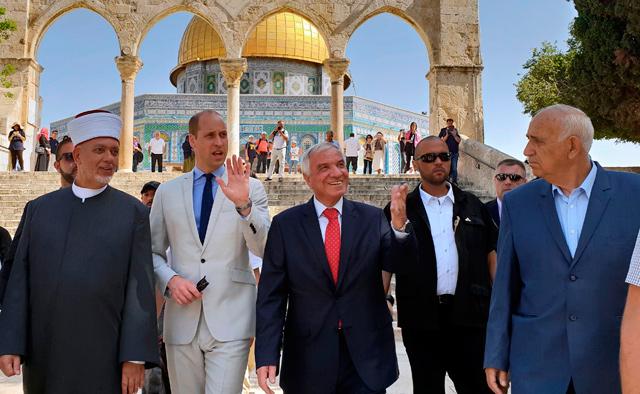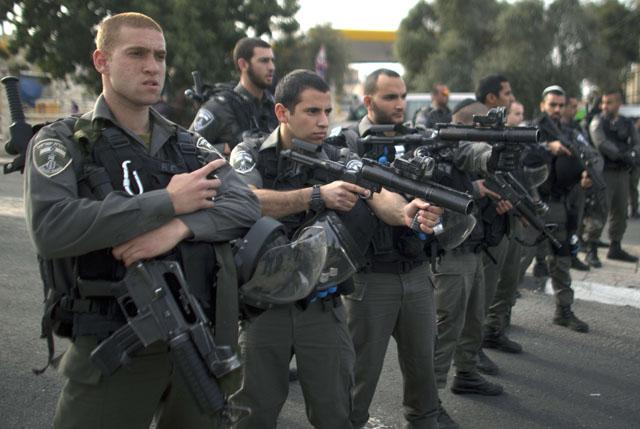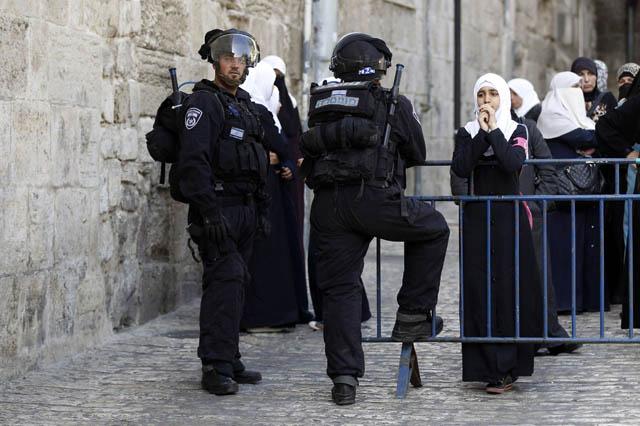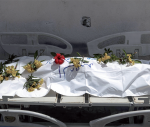You are here
Prince William visits Al Aqsa Mosque compound
By AFP - Jun 29,2018 - Last updated at Jun 29,2018

Britain’s Prince William (2nd left), accompanied by a group including Sheikh Azzam Al Khatib, director of the Islamic Waqf in Jerusalem, visits Al Aqsa Mosque compound in the Jerusalem’s Old City on Thursday (AFP photo)
OCCUPIED JERUSALEM — Prince William visited Jerusalem’s super-sensitive Al Aqsa Mosque/Al Haram Al Sharifon Thursday as he wrapped up a landmark Middle East tour during which he has tiptoed through the region’s diplomatic minefield.
His visit to Islam’s third holiest site was followed by visits to the city’s Jewish and Christian holy places.
William wandered through Al Aqsa compound accompanied by a large Israeli security detail and members of the Jordanian-run religious trust that administers it.
British officials said it was the first time a member of the royal family had ever visited the compound, which houses Al Aqsa Mosque and the iconic golden-topped Dome of the Rock.
The second-in-line to the British throne also visited the adjacent Western Wall, the holiest place at which Jews pray, accompanied by its director general and by Britain’s Chief Rabbi Ephraim Mirvis.
Since Israel occupied Arab East Jerusalem in the Six-Day War of 1967, Jewish extremists have campaigned for the right to pray inside the mosque compound, the most inflammatory single issue of the Middle East conflict.
Both the second Palestinian uprising that erupted in 2000 and a new wave of deadly violence that broke out last year had their roots in Palestinian fears for the longstanding status quo at the compound.
‘God of Peace’
Donning a dark Jewish skullcap for his visit to the Western Wall, William placed a note in a crack between the ancient stones before laying his hand on them and closing his eyes for a few moments.
It is customary to place written prayers or requests in the stones that Jews believe were the support wall of their alleged ancient temple.
The prince then signed the visitors’ book, with the Western Wall administration saying his dedication read: “May the God of peace bless this region and all the world with peace.”
From the Western Wall, the prince walked through the narrow alleyways of Jerusalem’s walled Old City to the Church of the Holy Sepulchre, which most Christians believe is the site where Jesus was crucified and buried.
There he was greeted by representatives of the sometimes feuding Christian denominations which administer the church before touring its vast multilevelled interior.
He then reentered the Old City’s narrow streets for the short walk to Jaffa Gate, where he rejoined his motorcade, capping off his three-day tour.
On Wednesday, William found himself on diplomatic thin ice during a visit to the Israeli-occupied West Bank when he called the Palestinian territories a country.
At a meeting with Palestinian President Mahmoud Abbas in Ramallah, the prince appeared to fall foul of the complex language surrounding the Middle East conflict.
“I am very glad that our two countries work so closely together and have had success stories with education and relief work in the past”, he told Abbas, speaking without notes.
Western governments typically refrain from referring to the Palestinian territories as a country or state, instead supporting the Palestinian demand for sovereignty in the future.
The right-wing Likud party of Israeli Prime Minister Benjamin Netanyahu, who the prince met in Jerusalem on Tuesday, rejects Palestinian statehood and supports illegal Jewish settlement in the occupied West Bank.
Related Articles
OCCUPIED JERUSALEM — US Secretary of State Mike Pompeo accompanied Israel's prime minister on a visit to the Western Wall in Jerusalem's Old
A far-right Israeli Cabinet minister on Sunday paid a brief visit to the flashpoint Al Aqsa Mosque compound in Jerusalem’s Old City, an Israeli security official said.
Dozens of Palestinians were wounded in clashes with Israeli forces that erupted Wednesday when Jerusalem’s flashpoint Al Aqsa Mosque compound was opened to Jewish visitors, an AFP correspondent said.


















